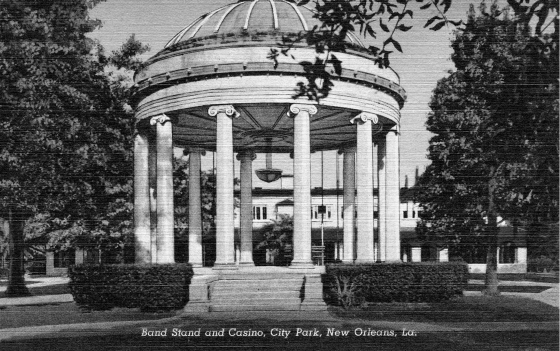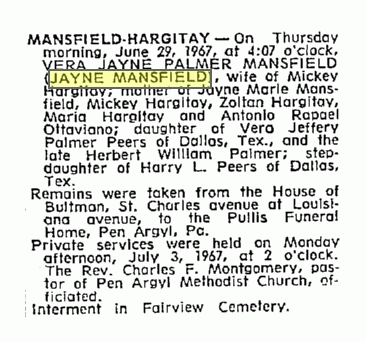|
Today in New Orleans History |
|
|
July 4


 City Park Popp Bandstand is Dedicated  

To receive an update for each day in New Orleans
history, join our facebook page
- Today in New Orleans History
ARMSTRONG, Louis, jazz trumpeter, singer, band leader. reportedly Born, July 4, 1900,
(Armstrong often stated that he was born on July 4, 1900, a date that has been noted in many biographies. Although he died
in 1971, it was not until the mid-1980s that his true birth date of August 4, 1901 was discovered by researcher Tad Jones
through the examination of baptismal records) traditionally given, but recent biogra-pher places birthdate sometime
in 1898, in Jane Alley, New Orleans, La.; son of Willie Armstrong and Mary Ann "Mayann" (Miles?) of Boutté,
La. Reared in early childhood by grandmother, Josephine Armstrong; arrested for firing a pistol on New Year's Eve, 1912
or 1913; sent to Colored Waifs' Home; joined Colored Waifs' Home Band, under the direction of Peter Davis (q.v.), playing
first the tambour¬ine, then the drum, and the alto horn, before the cornet; was essentially a self-taught musi¬ci¬an;
left the Home in 1914 or 1915 and worked at various jobs and sat in for cornet¬ists in honky-tonks around New Orleans;
Joe "King" Oliver (q.v.), his sponsor and teacher, brought him to Chicago; replaced Oliver in 1918 or 1919 in Kid
Ory's (q.v.) Band. Married Daisy Parker in 1918. In May 1919 joined Fate Marable's Band sailing out of St. Louis for a
cruise on the Mississippi on the Dixie Belle. Wrote "I Wish I Could Shimmy Like My Sister Kate" which he sold
for $50. Returned to New Orleans in September 1921, playing with various bands including Papa Celestin's (q.v.) Tuxedo Band;
joined Oliver in Chicago in 1922. Divorced first wife in 1923 and married Lillian Hardin in February 1924; joined wife's
band, "Lil Armstrong's Dreamland Syncopators" in 1925; switched from cornet to trumpet between 1925 and 1928 and
during that time made the famous "Hot Fives" and "Hot Sevens" recordings under his own name; improvisations
on his trumpet moved Dixieland jazz from ensemble playing; became the central jazz innovator of his time; originated what
came to be called "Scat" singing; played with various bands and with his own "Louis Armstrong and his Stompers";
toured the United States and in July 1932 embarked on first European tour. Acquired in England the nickname, "Satchmo,"
a garbling of his original nickname, "Satchelmouth". Alternated touring the United States, Europe, and the rest
of the world for the remainder of his life. In the 1930s began making film appearances in Ex-Flame (1931), Rhapsody in
Black and Blue (1932), Pennies from Heaven (1936), Atlantic City (1944), A Song Is Born (1948), The Glenn Miller Story (1953),
High Society (1956), and Hello Dolly (1969); Broadway appearances in-clude "Hot Chocolates" (1929), in which he
introduced Fats Waller's "Ain't Misbehavin," and "Swingin' the Dream" (1939). Divorced Lil Hardin in
1932 and married Alpha Smith in 1938 but was divorced from her also. In 1942 married Lucille Wilson, his wife for the remainder
of his life; toured in the 1930s and 1940s fronting big bands and playing popular music rather than blues or jazz; put together
a smaller band, the "All Stars," in 1947 when decline of big bands began. Toured the world for the next three
decades sometimes sponsored by the U. S. State Department as America's "Goodwill Ambassador"; seldom played New
Orleans because of segregation laws. Returned for Mardi Gras in 1949 to be crowned King Zulu; received a cheering reception
playing a benefit in New Orleans in 1965. Died in his sleep at his home in Corona, Queens, N.Y., on July 6, 1971; survived
by his wife, Lucille, and his cousin, Clarence, whom he had adopted; interred Flushing, N. Y. cemetery. Singer Bowl, in
Flushing Meadows Park, Queens, N.Y., was renamed Louis "Satchmo" Armstrong Park and Stadium and dedi-cated in
October 1972; Armstrong Park on Rampart Street in New Orleans is a $10-million, thirty-one-acre park dominated by a twelve-foot
statue of the jazzman; ten years in the planning it was dedicated in April 1980. D.W.M. Sources: James Lincoln Collier,
Louis Armstrong, An American Genius (1983); Louis Armstrong, Satchmo: My Life in New Orleans (1954); Max Jones and John
Chilton, Louis: The Louis Armstrong Story, 1900-1971 (1971); Leonard Feather, The Encyclopedia of Jazz (1955); William
Russell, "Louis Armstrong," in Frederic Ramsey, Jr., and Charles Edward Smith, eds., Jazzmen (1939). Fromhttp://lahistory.org/site18.php
On Saturday, April 30, 1803, the Louisiana Purchase Treaty was signed by Robert
Livingston, James Monroe, and Barbé Marbois in Paris. Jefferson announced the treaty to the American people on July
4. After the signing of the Louisiana Purchase agreement in 1803, Livingston made this famous statement, "We
have lived long, but this is the noblest work of our whole lives...From this day the United States take their place among
the powers of the first rank." The United States Senate ratified the treaty with a vote of twenty-four to seven
on October 20. The Senators who voted against the treaty were: Simeon Olcott and William Plumer of New Hampshire, William
Wells and Samuel White of Delaware, James Hillhouse and Uriah Tracy of Connecticut, and Timothy Pickering of Massachusetts.
On the following day, the Senate authorized President Jefferson to take possession of the territory and establish a temporary
military government. In legislation enacted on October 31, Congress made temporary provisions for local civil government
to continue as it had under French and Spanish rule and authorized the President to use military forces to maintain order.
Plans were also set forth for several missions to explore and chart the territory, the most famous being the Lewis and Clark
Expedition. France turned New Orleans over on December 20, 1803 at The Cabildo. On March 10, 1804, a formal ceremony was conducted
in St. Louis to transfer ownership of the territory from France to the United States. Effective on October 1, 1804, the purchased
territory was organized into the Territory of Orleans (most of which became the state of Louisiana) and the District of Louisiana,
which was temporarily under the control of the governor and judges of the Indiana Territory. |
||
|

To receive an update for each day in New Orleans history,
join our facebook page - Today in New
Orleans History.
Analytics |



